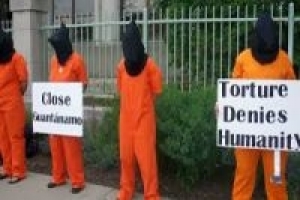The grisly details of CIA torture have finally been at least partly aired through the release this Tuesday, 9 December of the executive summary to a landmark Senate intelligence committee report. The extent of the torture has been covered extensively across the media, and is horrifying. But much of the media coverage of this issue is missing the crucial bigger picture: the deliberate rehabilitation of torture under the Obama administration, and its systematic use to manufacture false intelligence to justify endless war.
Torture victims, who had been detained by the US national security apparatus entirely outside any sort of recognizable functioning system of due process, endured a litany of extreme abuses normally associated with foreign dictatorships: 180-hour sleep deprivation, forced "rectal feeding," rectal "exams" using "excessive force," standing for dozens of hours on broken limbs, waterboarding, being submerged in iced baths, and on and on.
Yet for the most part, it has been assumed that the CIA’s "enhanced interrogation program" originated under the Bush administration after 9/11 and was a major “aberration” from normal CIA practice, as one US former military prosecutor put it in the Guardian. On BBC Newsnight yesterday, presenter Emily Maitlis asked Zbigniew Brzezinski, former National Security Adviser under Carter, about the problem of “rogue elements in the CIA,” and whether this was inevitable due to the need for secrecy in intelligence.
Media coverage of the Senate report has largely whitewashed the extent to which torture has always been an integral and systematic intelligence practice since the second World War, continuing even today under the careful recalibration of Obama and his senior military intelligence officials. The key function of torture, largely overlooked by the pundits, is its role in manufacturing nebulous threats that legitimize the existence and expansion of the national security apparatus. The CIA’s post-9/11 torture program was formally approved at the highest levels of the civilian administration. Yet the focus on the Bush administration serves a useful purpose. While the UN has called for prosecutions of Bush officials, Obama himself is excused on the pretext that he banned domestic torture in 2009, and reiterated the ban abroad this November.
Even Dan Froomklin of the Intercept congratulated the November move as a “win” for the “good guys.” Indeed, with the release of the Senate report, Obama’s declaration that he has ended “the CIA’s detention and interrogation program” has been largely uncritically reported by both mainstream and progressive media, reinforcing this narrative.
Yet Obama did not ban torture in 2009, and has not rescinded it now. He instead rehabilitated torture with a carefully crafted Executive Order that has received little scrutiny. He demanded, for instance, that interrogation techniques be made to fit the US Army Field Manual, which complies with the Geneva Convention and has prohibited torture since 1956.
But in 2006, revisions were made to the Army Field Manual, in particular through ‘Appendix M’, which contained interrogation techniques that went far beyond the original Geneva-inspired restrictions of the original version of the manual. This includes 19 methods of interrogation and the practice of extraordinary rendition. As pointed out by US psychologist Jeff Kaye who has worked extensively with torture victims, a new UN Committee Against Torture (UNCAT) review of the manual shows that a wide-range of torture techniques continue to be deployed by the US government, including isolation, sensory deprivation, stress positions, chemically-induced psychosis, adjustments of environmental and dietary rules, among others.
Indeed, the revelations contained in the Senate report are a mere fraction of the totality of torture techniques deployed by the CIA and other agencies.
On Jan. 22, 2009, retired Admiral Dennis Blair, then Obama’s director of national intelligence, told the Senate intelligence committee that the Army Field Manual would be amended to allow new forms of harsh interrogation, but that these changes would remain classified:
“We have large amounts of unclassified doctrine for our troops to use, but we don’t put anything in there that our enemies can use against us. And we’ll figure it out for this manual… there will be some sort of document that’s widely available in an unclassified form, but the specific techniques that can provide training value to adversaries, we will handle much more carefully.”
Obama’s supposed banning of the CIA’s secret rendition programs was also a misnomer. Obama did not really ban the CIA’s use of secret prisons either, permitting indefinite detention of people without due process “on a short-term transitory basis."
Declassified CIA training manuals from the 1960s, '70s, '80s and '90s, prove that the CIA has consistently practiced torture long before the Bush administration attempted to legitimize the practice publicly.
In his seminal study of the subject, A Question of Torture, US history professor Alfred W. McCoy of the University of Wisconsin-Madison proves using official documents and interviews with intelligence sources that the use of torture has been a systematic practice of US and British intelligence agencies, sanctioned at the highest levels, over “the past half century.” Since the second World War, he writes, a “distinctive US covert-warfare doctrine… in which psychological torture has emerged as a central if clandestine facet of American foreign policy.”
“From 1950 to 1962,” McCoy found, “the CIA became involved in torture through a massive mind-control effort, with psychological warfare and secret research into human consciousness that reached a cost of a billion dollars annually.” The pinnacle of this effort was the CIA’s Kubark Counterintelligence Interrogation handbook finalized in 1963, which determined the agency’s interrogation methods around the world. In the ensuing decade, the agency trained over a million police officers across 47 countries in torture. A later incarnation of the CIA torture training doctrine emerged under Freedom of Information in the form of the 1983 Human Resources Training Exploitation Manual.
One of the critical findings of the Senate report is that torture simply doesn’t work, and consistently fails to produce meaningful intelligence. So why insist on its use? For McCoy, the addiction to torture itself is a symptom of a deep-seated psychological disorder, rather than a rational imperative.
He is right, but in the post-9/11 era, there is more to the national security apparatus’ chronic torture addiction than this. It is not a mere accident that torture generates vacuous intelligence, yet continues to be used and justified for intelligence purposes. For instance, the CIA claimed that its torture of alleged 9/11 mastermind Khalid Sheikh Mohammed (KSM) led to the discovery and thwarting of a plot to hijack civilian planes at Heathrow and crash them into the airport and buildings in Canary Wharf. The entire plot, however, was an invention provoked by torture that included waterboarding, “facial and abdominal slaps, the facial grab, stress positions, standing sleep deprivation” and “rectal rehydration.”
Torture also played a key role in the much-hyped London ricin plot. Algerian security services alerted British intelligence in January 2003 to the so-called plot after interrogating and torturing a "terrorist suspect," former British resident Mohammed Meguerba. We now know there was no plot. Four of the defendants were acquitted of terrorism and four others had the cases against them abandoned. Only Kamal Bourgass was convicted after he murdered Special Branch Detective Constable Stephen Oake during a raid. Former British ambassador to Uzbekistan, Craig Murray, has also blown the whistle on how the CIA would render "terror suspects" to the country to be tortured by Uzbek secret police, including being boiled alive. The confessions generated would be sent to the CIA and MI6 to be fed into "intelligence" reports. Murray described the reports as “bollocks,” replete with false information not worth the “bloodstained paper” they were written on.
Many are unaware that the 9/11 Commission report is exactly such a document. Nearly a third of the report’s footnotes reference information obtained from detainees subject to "enhanced" interrogation by the CIA. In 2004, the commission demanded that the CIA conduct “new rounds of interrogations” to get answers to its questions. As investigative reporter Philip Shennon pointed out in Newsweek, this has “troubling implications for the credibility of the commission’s final report” and “its account of the 9/11 plot and al-Qaeda’s history.” Which is why lawyers for the chief 9/11 mastermind suspects now say after the release of the Senate report that the case for prosecution may well unravel.
That torture generates false information has long been known to the intelligence community.
By deploying the same techniques, the intelligence community was not seeking to identify real threats; it was seeking to manufacture threats for the purpose of justifying war. As David Rose found after interviewing “numerous counterterrorist officials from agencies on both sides of the Atlantic,” their unanimous verdict was that “coercive methods” had squandered massive resources to manufacture “false leads, chimerical plots, and unnecessary safety alerts.”
Far from exposing any deadly plots, torture led only to “more torture” of supposed accomplices of terror suspects “while also providing some misleading 'information' that boosted the administration’s argument for invading Iraq.” But the Iraq War was not about responding to terrorism. According to declassified British Foreign Office files, it was about securing control over Persian Gulf oil and gas resources, and opening them up to global markets to avert a portended energy crisis. In other words, torture plays a pivotal role in the Pentagon’s posture of permanent global war: generating spurious overblown intelligence that can be fed-in to official security narratives of imminent terrorist threats everywhere, in turn requiring evermore empowerment of the security agencies, and legitimizing military expansionism in strategic regions.
The Obama administration is now exploiting the new Senate report to convince the world that the intelligence community’s systematic embroilment in torture was merely a Bush-era aberration that is now safely in the past. Do not be fooled. Obama has rehabilitated and recalibrated the covert torture apparatus, and is attempting to leverage the torture report’s damning findings to claim moral high ground his administration doesn’t have. The torture regime is alive and well, but it has been put back in the box of classified secrecy to continue without public scrutiny.
The above feature was authored by Nafeez Ahmad.
Nafeez Ahmed is an investigative journalist, author and contributor to numerous newswires and media outlets.
RM/ME


















